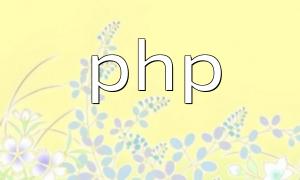PHP는 웹 개발에 널리 사용되는 프로그래밍 언어입니다. 강력한 라이브러리 및 기능 지원을 통해 HTML을 동적으로 생성하는 것이 매우 간단합니다. 이 기사는 PHP의 파일 작업 및 문자열 처리 기능을 사용하여 HTMLGenerator 클래스를 생성하여 HTML 파일을 생성하는 방법을 소개합니다.
먼저, 우리는 htmlgenerator라는 클래스를 정의해야합니다. 이 클래스는 HTML 파일의 내용을 생성 할 책임이 있으며 간단한 기능으로 관리 할 수 있습니다.
class HTMLGenerator {
private $title;
private $content;
public function __construct($title) {
$this->title = $title;
$this->content = '';
}
public function addSection($sectionTitle, $sectionContent) {
$this->content .= "<h2>" . $sectionTitle . "</h2>";
$this->content .= "<p>" . $sectionContent . "</p>";
}
public function generateHTML() {
$html = "<!DOCTYPE html>\n";
$html .= "<html>\n";
$html .= "<head>\n";
$html .= "<title>" . $this->title . "</title>\n";
$html .= "</head>\n";
$html .= "<body>\n";
$html .= $this->content;
$html .= "</body>\n";
$html .= "</html>";
return $html;
}
public function saveHTML($filename) {
$html = $this->generateHTML();
file_put_contents($filename, $html);
}
}
htmlgenerator 인스턴스를 만들고 제목을 전달함으로써 추가 방법을 사용하여 여러 하위 섹션 컨텐츠를 추가 할 수 있습니다. 각 섹션에는 자체 제목과 텍스트가 있습니다.
$generator = new HTMLGenerator("My Awesome Website");
$generator->addSection("Introduction", "This is an introduction to my website.");
$generator->addSection("Features", "Here are some features of my website.");
$generator->addSection("Contact", "You can contact me through the contact form.");
HTML 컨텐츠 생성을 완료 한 후 SaveHTML 메소드를 사용하여 생성 된 HTML 코드를 파일에 저장할 수 있습니다.
$generator->saveHTML("index.html");
생성 된 HTML 파일 컨텐츠는 다음과 같습니다.
<!DOCTYPE html>
<html>
<head>
<title>My Awesome Website</title>
</head>
<body>
<h2>Introduction</h2>
<p>This is an introduction to my website.</p>
<h2>Features</h2>
<p>Here are some features of my website.</p>
<h2>Contact</h2>
<p>You can contact me through the contact form.</p>
</body>
</html>
이 기사는 PHP를 통해 잘 구조화 된 HTML 파일을 생성하는 방법을 보여줍니다. 우리는 HTMLGenerator 클래스를 만들고 하위 섹션 컨텐츠를 동적으로 추가하는 방법을 보여주었습니다. PHP의 파일 조작 함수를 사용함으로써 생성 된 HTML은 결국 로컬 파일로 저장 될 수 있습니다. 이 방법을 사용하면 개발자가 HTML 파일을 신속하게 만들고 관리하고 웹 컨텐츠를 유연하게 사용자 정의 할 수 있습니다.









